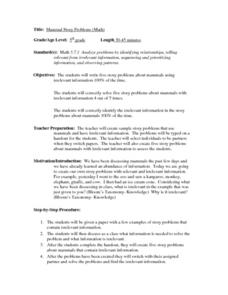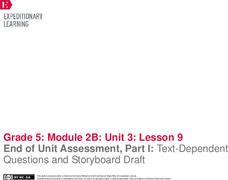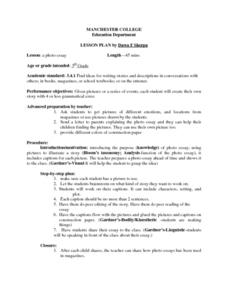Curated OER
When A Story Met A Sandwich
How is a story like a peanut butter and jelly sandwich? Use making a sandwich as a metaphor to remind your writers that a good, solid beginning, a rich and rewarding middle, and an ending that brings everything together spices up a...
Curated OER
Sequencing
Second graders retell a story focusing on sequence. in this sequence activity, 2nd graders read the story Carry Go Bring Come by Vyanne Samuels. They retell parts of the story and put them in the correct order.
Curated OER
How can we write a silly story?
Second graders use the writing process and create a silly story. In this silly story instructional activity, 2nd graders will review person, event and setting and complete a chart for each. Students will put a person,...
Curated OER
Mammal Story Problems (Math)
Fifth graders, after discussing the teacher's handout examples, practice writing five story problems about mammals using relevant/irrelevant information. As a class, they solve the story problems while identifying the key concepts that...
Curated OER
Story Retellings
Second graders complete story maps in order to retell stories to the class.
Curated OER
Let Freedom Sing: A Patriotic Program for Grades 1 - 6
Students explore the history, meaningful background, and significance of Patriotic songs in the eight lessons of this unit. Each of the different grade levels experience a different amount of lessons all culminating in a Patriotic Program.
Scholastic
Tell Us a Tale: Teaching Students to Be Storytellers
Encourage scholars to retell their favorite short story or folktale, adding personal details to make it their own. After reading their book of choice several times, story tellers retell a tale verbally to their classmates.
Curated OER
The Magic Apple
A fun and delicious lesson plan can help your kids learn about plural nouns and story sequencing. After reading The Magic Apple by Rob Cleveland, kids match pictures to story segments and add s to nouns to make them...
EngageNY
End of Unit Assessment, Part 1: Text-Dependent Questions and Storyboard Draft: “You Can Do a Graphic Novel” Excerpt
Eyes on the finish line. Serving as the first part of the end of unit assessment, learners answer questions based on a text about how to write a graphic novel. Using what they've learned, they then create a storyboard about the invention...
Curated OER
My Favorite Birthday Story
Happy birthday! Pre-K and Kindergarten students bring in a photograph of their favorite birthday party. They get together in small groups and write about the birthday - with the help of adults. The stories and the photos are displayed on...
Curated OER
Retelling Main Event in Sequence
Second graders practice retelling events from a fiction book. In this reading comprehension lesson plan, 2nd graders read Harry and the Lady Next Door and retell the main events of the story to a partner.
Curated OER
Sequence of Events
Third graders discuss the importance of putting events into the correct sequence. In groups, they put the order of events of different stories into the correct order while completing a worksheet. To end the lesson, they identify the...
Curated OER
A Photo Essay
Students analyze photographs, then create their own photo essays by using photos, magazine pictures or drawings to illustrate their stories.
Curated OER
Learning to Summarize a Story
Students with hearing loss read independently and understand what is being read to them. For this independent reading lesson plan, students sequence and discuss the book that is read.
Curated OER
Making a Magical Story
Students create their own magical story. In this story writing lesson, students listen to the story The Lion, The Witch, and the Wardrobe b C.S. Lewis to find the basic elements of a story. They come up with their own magical...
Curated OER
Introduction to Limits
High schoolers practice using graphing calculators and spreadsheets as they explore numeric limits using sequences and functions. They complete a sequencing worksheet, and determine which sequence corresponds to story a story called...
Curated OER
Parts of the Plot: Constructing a Plot Diagram
Sixth graders conduct a plot diagram for a short story. They identify the problem, the rising action, the climax, the falling action, and the resolution. Students are able to sequence events in a story, and identify the parts of the plot...
Curated OER
Snow Globe Family
Kindergartners sequence the parts of a story using a snow globe as a setting. They will listen to Snow Globe Family and retell the parts of the story noting the beginning, the middle, and the end. Then they will make their own snow...
Curated OER
An Amazing Story
Pupils develop sequential stories to guide a partner through a computer-generated maze. In pairs they illustrate each place and character listed, build and print a maze, and write a class-generated story.
Curated OER
Order! Order!
Polish organization skills in your youngsters. With this lesson, they are introduced to the trait of organization and participate in activities that reinforce organization. They cut apart a familiar story, receive different...
University of Arizona
Yoruba Legends: Southern Nigeria
Explore legends and storytelling with your learners. After listening to some legends, pupils work collaboratively and then individually to come up with original legends about animals.
University of Arizona
Fusing Firecrackers with Narrative
Improve your youngsters' descriptive writing. They study an object and write about what they see as a warm-up, then they read an excerpt from Paul Guest's memoir, One More Theory about Happiness. The next part of the...
Curated OER
Thrilling Information: Music and Reading
Here’s a cross-curricular program music activity that uses Peer Gynt to engage class members. Groups take one section of “In the Hall of the Mountain King,” choreograph their section of the tune to represent the story as they imagine it,...
Curated OER
Sequence Of Events
Third graders are introduced to the concept of sequence of events. They work in groups to properly sequence The Three Little Pigs, then work individually to write their own stories about their individuality.























